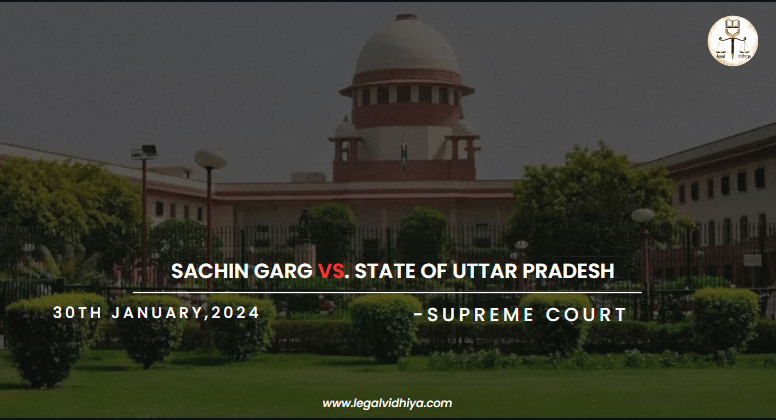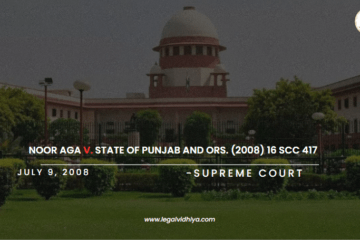
| CITATION | (Cr) no.4415 of 2023 |
| DATE OF JUDGEMENTS | 30th January,2024 |
| COURT | Supreme Court of India |
| APPEALLENT | Sachin Garg |
| RESPONDENT | State of Uttar Pradesh and ANR. |
| BENCH | Sanjay Kumar, Aniruddha Bose J. |
INTRODUCTION
The Sachin Garg vs. State of Uttar Pradesh & ANR. case, decided on January 30, 2024, involves a dispute over payment for the supply of Dissolved Acetylene Gas (DA Gas). Sachin Garg was the Head of the factory at Exide Industries Limited (EIL) in Bawal, District Rewari, Haryana. The respondent, who ran a proprietary concern called Ambika Gases, supplied DA Gas used for manufacturing batteries in the EIL factory. The dispute centres around a purchase order issued for the supply of DA Gas. The original purchase order, dated April 1, 2019, was amended twice i.e. first amendment (July 18, 2019): Increased the rate from Rs. 1.55 per unit to Rs. 1.65 per unit and second amendment (December 20, 2019): Reduced the rate per unit to Rs. 1.48 from Rs. 1.65. An invoice was raised by the respondent for a total sum of Rs. 9,36,693.18/-.
FACTS OF THE CASE
- The case of Sachin Garg vs. State of Uttar Pradesh pertains to an application filed under Section 482 of the Criminal Procedure Code (CrPC).
- It sounds like respondent no.2, who ran Ambika Gases, supplied Dissolved Acetylene Gas for making batteries in the factory. The issue in the current appeal seems to revolve around a purchase order for this item. The original order from 01.04.2019 was changed twice based on respondent no.2’s requests.
- So, respondent no.2 filed a complaint case in the Court of the Chief Judicial Magistrate, Ghaziabad. In the complaint, it was mentioned that the applicant’s company did the job work of D.A. Gas, and Sachin Garg from Exide Industries Ltd. issued Purchase Orders and made payments. The transaction was smooth until issues arose regarding payments, leading to a legal complaint.
- The Magistrate took action after recording the initial statements of Saurabh Sharma and his father Padam Kant Sharma. They issued summons for trial under Sections 406, 504, and 506 of the Indian Penal Code on August 18, 2021. This step indicates that the legal process is moving forward based on the information provided during the initial dispute.
- The case is diving deep into legal intricacies, especially with the examination of factors for quashing an FIR at the threshold. The principles laid down in the R.P. Kapur case highlights the inherent powers of the High Court under Section 482 of the Code to prevent abuse of court processes or ensure justice. The exceptions mentioned in the judgment provide insight into when the court may intervene in criminal proceedings.
- The Bhajan Lal case is being referenced in the Neeharika Infrastructure Ltd. decision.
- The breakdown of the Deepak Gaba case court scrutinized the evidence and legal requirements under Section 405 IPC to determine the outcome. The importance of establishing key elements like entrustment and dishonest misappropriation really shows the complexity of criminal cases. It’s like putting together a legal puzzle where every piece needs to fit perfectly for a case to stand.
- The references to the cases of Prof. R.K.Vijayasarathy vs. Sudha Seetharam and Vijay Kumar Ghai vs. State of West Bengal provide additional insights into the legal interpretations related to similar issues. criminal offenses like cheating or criminal breach of trust under Section 405 of the Penal Code adds another layer of legal nuance to these situations.
- Referring to the judgment of the Court in the case of Jagdish Ram vs. State of Rajasthan, it’s highlighted that a Magistrate can take cognizance based on the material available, even if the police have a different opinion. The distinction between the police investigation and the Magistrate’s role in determining sufficient grounds for proceeding, not conviction, is crucial.
- The cases of Birla Corporation Ltd. vs. Adventz Investments and Holdings Ltd. and Smt Nagawwa vs. Veeranna Shivalingappa Konjalgi further emphasize this legal perspective. Additionally, the insights from the case of Fiona Shrikhande vs. State of Maharashtra shed light on the interpretation of complaints involving criminal intimidation, emphasizing the holistic reading of the complaint rather than a word-for-word analysis. The legal nuances in these cases showcase the intricate balance between evidence, legal procedures, and the Magistrate’s role in the judicial process.
- The discussion about the rate revision in an ongoing commercial transaction and the lack of evidence for the offense under Section 405/406 adds depth to the legal perspective. The reference to the case of Binod Kumar and Ors. -vs- State of Bihar and Another further enriches the understanding of criminal.
- The reference to the case of Sharad Kumar Sanghi vs. Sangita Rane adds an interesting layer to the discussion. The distinction between attributing wrongdoing to the appellant directly versus involving the company as an accused is a crucial point of contention.
ISSUES
- Whether the complaint and summoning order revealed an offence under Sections 405, 406, 504 and 506 of the IPC?
- Whether the dispute was a civil dispute arising from a breach of contract rather than a criminal offence?
- Whether the complaint could be maintained without arraigning the principal company (EIL)?
APPEALENT`S ARGUMENTS
- The applicant’s counsel contended that the commercial transaction did not amount to an offense under Section 406 IPC.
- Referring to Binod Kumar and others Vs. State of Bihar (reported in 2014), the applicant’s lawyer emphasized that no dishonest intention existed in misappropriating the property.
- The allegations lacked substance regarding cheating or wrongful gain to the appellants.
RESPONDENT`S ARGUMENTS
- senior counsel for the opposite party argued that the complaint had been treated as a complaint case under Section 156(3) Cr.P.C.
- The court had recorded statements of the complainant and the sole witness under Sections 200 and 202 Cr.P.C.
- Learned APP for the State submits that petitioners are the only accused persons and respondent No. 2 is the only complainant/victim.
JUDGEMENT
In the case of Sachin Garg v. State of U.P., the judgment was pronounced by Hon’ble Mr. Justice Aniruddha Bose and Hon’ble Mr. Justice Sanjay Kumar. The appeal was allowed in terms of the signed reportable judgment, which is placed on the file. Any pending applications stand disposed of. Allahabad High Court judgment dated March 23, 2023. The case involved an application under Section 482 Cr.P.C. seeking to quash the impugned summoning order in Criminal Complaint Case No. 7990 of 2020 (Saurabh Sharma Vs. Sachin Garg). The charges included Sections 406, 504, and 506 IPC. The applicant argued that there was a commercial transaction of Rs. 9 lakhs between him and the opposite party, leading to an accounting dispute. The applicant relied on the judgment of the Apex Court in the case of Binod Kumar and others Vs. State of Bihar, where it was held that no allegations were made attracting the ingredients of Section 405 IPC.
ANALYSIS
The Supreme Court granted the appeal, dismissing the complaint and quashing the order. The Court ruled that the allegations made by respondent no.2 did not constitute an offence under Sections 405, 406, 504, and 506 of the IPC because they lacked the essential ingredients of dishonest misappropriation, conversion, use or disposal of property, dishonest intention of inducement, intentional insult, or threat to cause injury. The Court stated that the disagreement was solely business in nature and contained no element of criminality. The Court also remarked that respondent no.2 ascribed the misconduct to the appellant, despite the fact that the work was done for EIL, and that the allegation of criminal intimidation was ambiguous. The Court concluded that the learned Magistrate had failed to apply his mind in issuing summons, and the High Court had failed to exercise its jurisdiction under Section 482 of the Code of Criminal Procedure, 1973, to prevent the Criminal Court from abusing its power. As a result, the Court reversed the assailed verdict and dismissed the criminal case.
CONCLUSION
IPC, is liable to be quashed. It was accordingly set aside the impugned judgment and quashed the Criminal Complaint Case No.7990 of 2020 as also the summoning order issued on 18.08.2021. The appeal stands allowed in the above terms. All consequential steps in connection with the said proceeding shall stand quashed.
REFERENCE
- https://www.scconline.com/blog/post/2024/02/01/supreme-court-quashes-case-commercial-dispute-given-colour-of-criminal-offence/
- https://indiankanoon.org/doc/39319898/
-Written By PRIYANCE SHARMA an intern under legal vidhiya.
Disclaimer: The materials provided herein are intended solely for informational purposes. Accessing or using the site or the materials does not establish an attorney-client relationship. The information presented on this site is not to be construed as legal or professional advice, and it should not be relied upon for such purposes or used as a substitute for advice from a licensed attorney in your state. Additionally, the viewpoint presented by the author is of a personal nature.




0 Comments